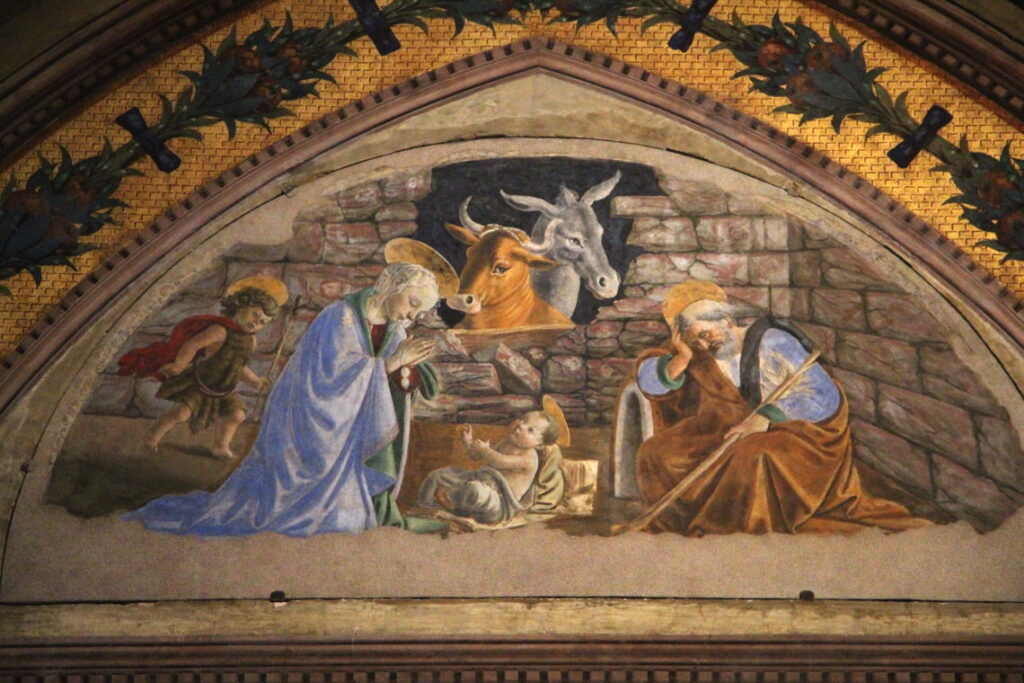The origins of painted Nativity scenes

This Christmas, I look at that most traditional of Christian religious paintings, the Nativity, during its formative period from the late Middle Ages to the Renaissance.
Paintings of the Nativity are closely related to the ‘scenes’ of models or performers that became popular after their introduction by Saint Francis of Assisi in 1223. Images of the Adoration of the Magi had started to appear on sarcophagi in the catacombs of Rome before the conversion of Emperor Constantine in about 312 CE, but pure Nativities were less frequent until their widespread adoption in churches throughout Europe during the thirteenth century.
Key pictorial elements include the swaddled infant Jesus, an ox and an ass, and the figures of Mary and Joseph, although they weren’t always present in the earliest depictions. In its purest form, the Nativity is distinct from adorations, of either the shepherds or the Magi, although there are often attendant angels, and maybe the occasional shepherd.
Margarito d’Arezzo (fl c 1250-1290), The Virgin and Child Enthroned, with Scenes of the Nativity and the Lives of the Saints (c 1263-4), egg tempera on wood, 92.1 x 183.1 cm, The National Gallery, London. Wikimedia Commons.
Margarito d’Arezzo’s The Virgin and Child Enthroned, with Scenes of the Nativity and the Lives of the Saints (c 1263-4) includes a Nativity scene at the top left meeting those requirements.
Duccio di Buoninsegna (1255–1319), The Nativity with the Prophets Isaiah and Ezekiel (1308-11), tempera on panel, 48 x 87 cm, National Gallery of Art, Washington, DC. Wikimedia Commons.
It’s probably Duccio’s Nativity with the Prophets Isaiah and Ezekiel from 1308-11 that formed the prototype for centuries of subsequent paintings, with its humble shed set into rock, the Holy Family, and the attendant animals (ox, ass, sheep) and humans (shepherds, angels). This was installed at the high altar in the Duomo (cathedral) in Siena on 30 June 1311, and remained there for nearly two centuries, only being removed in 1506. Each panel has its own apposite Latin inscription.
Artist not known, Nativity of Jesus (1300s), fresco, Kakopetria, Cyprus. Wikimedia Commons.
This fourteenth century fresco showing the Nativity of Jesus in Kakopetria, Cyprus, puts a series of frames showing individual events in the full story, around a central image of the Nativity. This ingenious composition avoids repetition of that central image for the adoration of the Magi, for example, shown at the three o’clock position, so uses the format to help tell the story.
Robert Campin (1375/1379–1444), The Nativity (c 1415-1430), oil on panel, 84.1 × 69.9 cm, Musée des Beaux-Arts, Dijon, France. Wikimedia Commons.
Inevitably, when oil painting arrived in the Northern Renaissance, the Nativity was one of the first themes, here painted by Robert Campin some time between 1415-30. This is also an early example in which the scene has moved out from the cave that had become popular in southern Europe, to a shed more typical of local farms. The sparse background of earlier Nativities has been replaced with a landscape typical of the coast of northern Europe.
Petrus Christus (1425–1476), The Nativity (c 1445-50), oil on wood, 130 × 97 cm, The National Gallery of Art, Washington, DC. Wikimedia Commons.
The Renaissance then brought a succession of masterly religious paintings that aimed to be so realistic that they deceived the eye, including Petrus Christus’ The Nativity from about 1445-50. It still contains the essential elements, though: the infant Jesus is naked, rather than swaddled, resting on the ground in front of the Virgin Mary. To the left are the ox and ass, and on the right is a balding and bearded Joseph with his walking stick.
Sandro Botticelli (1445–1510), The Nativity (c 1473-5), fresco transferred to canvas, 160 x 140 cm, Columbia Museum of Art, Columbia, SC. Wikimedia Commons.
By 1500, Sandro Botticelli had already painted several conventional nativity scenes. Two surviving frescoes are typical: The Nativity (c 1473-5) above has been transferred to canvas and can now be seen in the Columbia Museum of Art, and that in the Basilica of Santa Maria Novella (1476-7) below is one of the recommended sites in Florence, Italy.
Sandro Botticelli (1445–1510), Nativity (1476-7), fresco, 200 x 300 cm, Basilica of Santa Maria Novella, Florence. Photo by Sailko, via Wikimedia Commons.
These follow the convention: the infant Christ, required to be at the centre of course, with Joseph the carpenter on one side, and the Virgin Mary on the other. They are within a semi-derelict cattle-shed, with a background of an ox and an ass, and there are attendant shepherds. Representatives of the angelic host are optional. Botticelli does a fine job in both cases, but these don’t have the greatness of his secular Primavera or The Birth of Venus.
Fra Bartolomeo (1472–1517), The Nativity (1504-07), oil on panel, 34 x 24.5 cm, Art Institute of Chicago, Chicago, IL. Wikimedia Commons.
Fra Bartolomeo’s Nativity from 1504-07 is innovative in using a landscape based on a drawing made in front of the motif for its background, which has also survived. The artist has populated the middle distance to add interest, and in the foreground is a simple nativity scene based on his fine tondo Adoration of the Child from 1499. He has also added a decoration of angels at the right, and in the heavens above.
Happy Christmas!




